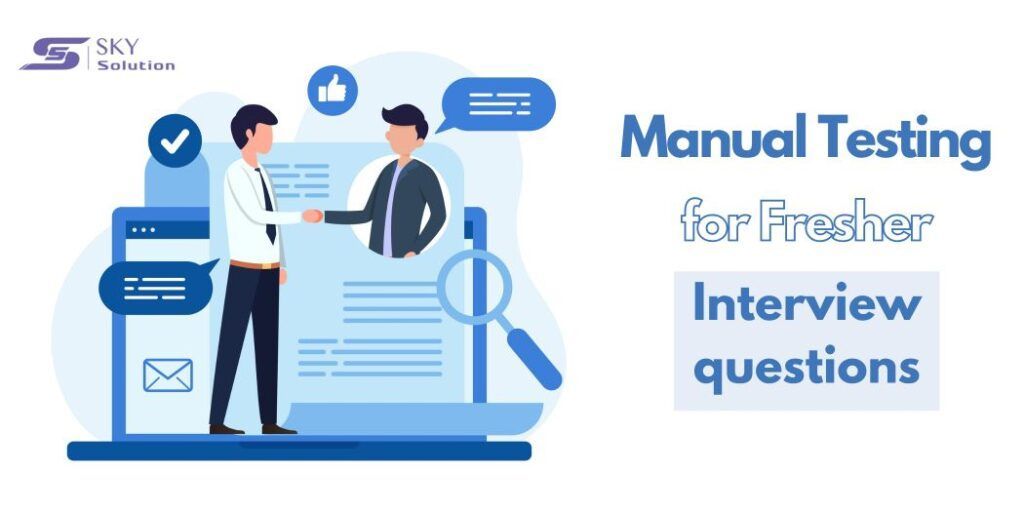In the competitive field of software testing, understanding Manual Testing Interview Questions is essential for both new and experienced testers. Sky Solution will outline common questions for manual testing positions, providing clear answers to help freshers prepare effectively.
I. 10 Manual Testing Interview Questions and Answers For Freshers
1.What is Manual Testing?
Manual testing is the process of manually checking software for defects; this method allows for thorough exploration of the software’s usability, functionality, and overall user experience. By performing manual tests, testers can identify issues that automated tests may overlook, ensuring a higher quality product.
2. What advantages does testing provide?
Testing provides several key benefits, including:
- Early defect detection: By identifying and addressing issues early in the development process, testing reduces the cost of fixing bugs later.
- Improved software quality: Regular testing ensures that the final product meets the specified requirements and is free of defects.
- Enhanced user satisfaction: Testing helps create a reliable and user-friendly application, leading to a better experience for users.
3.Under what circumstances is it appropriate to conclude testing?
Testing (both manual and automated) can be terminated when one or more of the following conditions are met:
- Last known bug fix: Once the last known bug has been addressed and the agreed-upon pass percentage value is achieved, the testing phase can be concluded.
- Testing deadline: If the testing deadline is met and no high-priority issues remain in the system, testing can be stopped.
- Mean Time Between Failure (MTBF): If the MTBF is long, indicating a stable product, the testing phase may be terminated based on stakeholder decisions.
- Code coverage: The testing phase can also conclude when the automated code coverage reaches a specified threshold value, provided there is a sufficient pass percentage and no critical bugs are present.
4.Which types of manual testing are considered most significant?
Some of the most widely used manual testing methods include:
- User Acceptance Testing (UAT): Conducted by the customer or end-user, this test ensures that the software meets the specified requirements and is ready for release.
- Black Box Testing: Also called functional testing, this approach evaluates an application’s functionality from the user’s point of view without considering internal code.
- White Box Testing: Known as clear-box or structural testing, this method examines the internal logic, structure, and workings of the software.
5.What is Quality Assurance, and what activities does it involve?
Quality assurance is a process-driven approach aimed at ensuring that the product development process is accurate and meets all relevant standards. It is considered a precautionary measure as it helps identify flaws in the software development process. Activities involved in quality assurance include document reviews, test case reviews, walkthroughs, and inspections.
6.How do verification and validation differ from each other?
The main distinctions between verification and validation are as follows:
- Verification: This involves evaluating various artifacts and the software development process to ensure that the developed product meets the required standards. It is a static process focused on document analysis rather than the actual end product. Verification is systematic and answers the question, “Are we building the product correctly?” Errors found during verification are generally less costly to fix compared to those discovered during validation.
- Validation: This process ensures that the developed software product meets specified business requirements. It involves running the software for dynamic testing. Validation is product-focused and answers the question, “Are we making the right product?” Errors identified during validation typically require more resources and are more expensive to correct if discovered later.
7.What are some drawbacks of manual testing?
Manual testing has several disadvantages:
- Human error is a significant risk.
- Some tasks may be challenging to perform manually, leading to increased time requirements.
- Costs can accumulate, making it more expensive in the long run.
- Manual testing is difficult to replicate, as it cannot be recorded.
8.What advantages does manual testing offer?
Manual testing offers several advantages:
- It is generally less expensive compared to automated testing.
- Testers receive accurate and quick visual feedback.
- It is ideal for testing small changes.
- It suits ad-hoc testing scenarios.
- Testers do not need prior knowledge of automation tools.
- It is particularly effective for UI testing.
9.What skills and qualifications are necessary for a manual software tester?
Manual software testers should possess the following qualifications:
- Problem-solving skills.
- Excellent written and verbal communication skills.
- Attention to detail.
- Ability to work under stress.
- Capability to work both independently and collaboratively.
- Strong organizational skills.
- Relevant technical skills.
10.What different categories of testing exist?
Testing can be categorized into two main types:
- Functional Testing: This confirms that the system meets its functional specifications.
- Non-Functional Testing: This evaluates non-functional requirements, such as performance, scalability, security, and portability.
Additionally, testing can be classified based on how it is performed: - Black Box Testing: The tester is unaware of the system’s internal architecture and interacts with the system solely through its interface.
- White Box Testing: This examines the system’s internal architecture and source code quality, focusing on code optimization, coverage, and reusability.
- Gray Box Testing: This involves a tester having limited access to the internal architecture, such as design documents, allowing for a more comprehensive evaluation of the application.
II. Conclusion
In conclusion, manual testing is vital for maintaining the quality and dependability of software products. With organizations placing greater emphasis on user experience, the need for proficient manual testers is growing. For newcomers aiming to establish a career in this area, it is important to grasp key concepts, different testing methods, and frequently asked interview questions.

